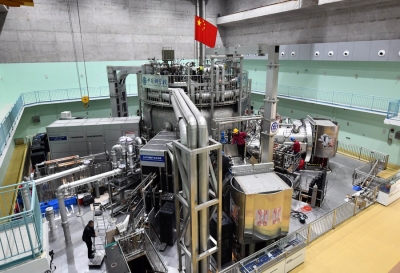China sustains artificial sun at record 120 mn C for over 100 sec
By IANS | Published: June 10, 2021 04:51 PM2021-06-10T16:51:03+5:302021-06-10T21:25:32+5:30
Beijing, June 10 China's "artificial sun" recently broke the world record as achieved a plasma temperature of 120 million ...

China sustains artificial sun at record 120 mn C for over 100 sec
Beijing, June 10 China's "artificial sun" recently broke the world record as achieved a plasma temperature of 120 million Celsius for 101 seconds and 160 million Celsius for 20 seconds, setting new records in the field of nuclear fusion, media reports said.
The experiment was achieved by Experimental Advanced Superconducting Tokamak (EAST) device, or the "Chinese artificial sun," located at the Hefei Institutes of Physical Science of the Chinese Academy of Sciences, the Global Times reported. EAST is part of the International Thermonuclear Experimental Reactor (ITER) facility a collaboration of 35 nations, also comprising India.
EAST is designed to replicate the nuclear fusion process that occurs naturally in the sun and stars to provide almost infinite clean energy through controlled nuclear fusion, which is often dubbed the "artificial sun."
Previously, the plasma could be maintained up to a temperature of 100 million Celsius for 100 seconds.
"The breakthrough is significant progress, and the ultimate goal should be keeping the temperature at a stable level for a long time," Li Miao, director of the Physics Department of the Southern University of Science and Technology in Shenzhen, was quoted as saying.
The next milestone might be to maintain the stability for a week or more, Li added.
Achieving a plasma temperature above 100 million Celsius is one of the key challenges to harness nuclear fusion. The temperature at the core of the sun is widely believed to be 15 million degrees Celsius, meaning that the plasma at the device's core will be seven times hotter than that of the sun.
The ITER project aims to prove that fusion power can be produced on a commercial scale and is sustainable.
ITER, the world's largest experimental fusion facility, is being built in Saint-Paul-les-Durance, some 35 km north of Aix-en-Provence in southern France.
India is one of the seven partners (China, India, Japan, South Korea, Russia, the US, and Europe) both in-kind and in-cash, in a first-of-a-kind global collaboration.
India has also, along with others, shipped ITER's massive first-of-a-kind magnets and other components to France.
The 1,250-ton cryostat base, the first two sections of which have been constructed by Larsen & Toubro (L&T), is India's largest single procurement contribution to the ITER facility that spans over 42 hectares.
Fusion is the process that powers the sun and the stars, when light atomic nuclei fuse together to form heavier ones, a large amount of energy is released.
Fusion research is aimed at developing a safe, abundant and environmentally-responsible energy source.
The project aims to complete through first plasma in 2025, a key milestone toward full fusion power by 2035.
Disclaimer: This post has been auto-published from an agency feed without any modifications to the text and has not been reviewed by an editor
Open in app